Irish Ferries
Irish Ferries is an Irish ferries operator, subsidiary of the Irish Continental Group which operates containers terminals in Belfast and Dublin in addition of ferries via Irish Ferries.
Irish Ferries is managed by Eamonn Rothwell and its headquarters are located in Dublin.
Irish Ferries' early years
The genesis of a ferry service between France and Ireland
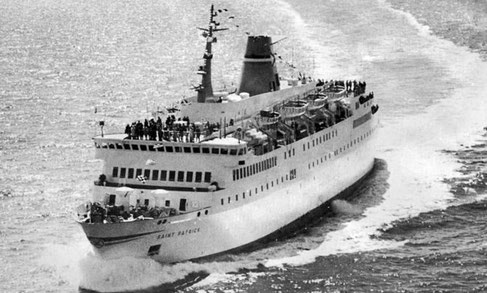
On 17th May 1968, the Irish Continental Group operated its first ferry service between Rosslare and Le Havre. Services were operated by a joint-venture including the operators Normandy Ferries and Saga, with services marketed by Irish Continental Group. The crossings were operated with two of Normandy Ferries' ships: Dragon and Lepoard. However, this service discontinued in 1971, when Normandy Ferries to ends its involvement in the joint venture, preventing any Ireland - France from being operated in 1972. Therefore, the Irish Government undertook negotiations with B+I Lines (a state-run company) and Irish Shipping to enable the resumption of this service for 1973.
Irish Shipping accepted to resume the service, and alongside with the Irish company Fearnley & Eger and the Swedish one Lion Ferry, established the Irish Continental Line in early-1972. The freshly-created company immediatly ordered to German shipyard Schichau Unterwesser a ship, launched in early-1973: Saint Patrick (1). It was the beginning of Irish Ferries' history.
Once introduced, Saint Patrick (1) soon became popular, since she was providing a comfortable and reliable service. Mainland became therefore popular to Irish holiday-maker whereas Ireland become popular to Mainland Holiday-makers. It soon caused an important of the traffics carried by the company. As soon as 1976, Irish Continental Line establish a subsidiary, Ferrytours to promote France as a nice destination for Irish Holiday-makers.
In 1977, Saint-Patrick (1) was purchased by the Irish Continental Group from Irish Shipping. It had little interest at the moment, but has enable the preservation of the service when Irish Shipping was liquidated in the mid-80s.
La liquidation d'Irish Shipping
After years of profit and growth, Irish Shipping signed several ruinous contract with Hong Kong-established ferries operators in 1979 and 1980, to charter out its ships. However, these were disastrous for the company, mainly owing to the cost of the ships' transfer to Hong Kong, funded by their owner, Irish Shipping.
Moreover, the world economical context was not good enough for maritime services operating RoRo ships, that were representing a large part of Irish Shipping's fleet, which therefore became very hard to charter. These two factors have caused the end of profitability for the company, with losses becoming more and more important.
Facing with disastrous situation, the Irish government did not have any other choice than putting under administration Irish Shipping in November 1984, prior to its liquidation. This left the young company Irish Continental Line, only survivor of the liquidation of its parent company, and hence, without owner.
The fast and troubled growth of Irish Continental Line
The fast expansion of the 70s
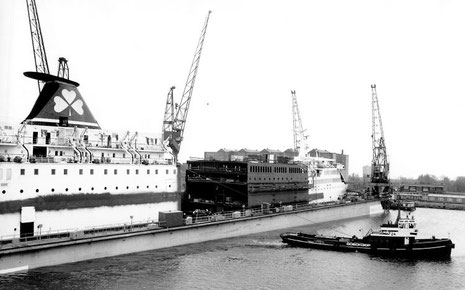
The strong growth of the traffics on the Rosslare - Le Havre route forced Irish Continental Line to purchase a second ship to operate the service. Irish Continental Line therefore decided to purchase in 1978 the ship that became Saint Killian, a 1973-built RoPax ferry. The same year, the Breton company Brittany Ferries established its own France - Ireland service, linking Cork and Roscoff.
However, the purchase of Saint Killian have not enabled Irish Continental Line solving forever its capacity issues. Indeed, the passengers, cars and freight figures grew that fast that in as soon as 1981, Irish Continental Line was unable again to cope with the growing traffic. Therefore, the company decided to replace Saint-Patrick (1) with a larger 1973-built ship, which was christened as Saint-Patrick (2). Saint-Patrick (2) was to provide additional capacity at summer time. Saint-Patrick (1) was sent to a new Belfast - Liverpool route, operated by freshly-created operated Belfast Car Ferry, as Saint Columb.
Moreover, Irish Continental Line decided to lengthen its other ship, Saint Killian. Therefore, a Amsterdam-established shipyard performed on Saint Killian a jumboisation between November 1981 and early-1982. Irish Continental Line has chosen lengthening Saint Killian rather than replacing her since it was faster and much cheaper. This 32m-jumboisation enabled Saint Killian providing accommodation for 600 extra-passengers in berths, whilst her garage could welcome an extra 100 cars. Renamed Saint Killian (2), she resumed service for Summer 1982.
From doubts to Modernisation
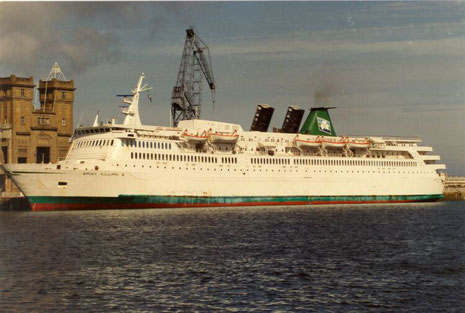
Following Irish Shipping bankruptcy in November 1984, Irish Continental Line was left without owners. Fortunately, the ships were not owned by Irish Shipping, ensuring the company's future since they have not been sold to other companies during Irish Shipping's liquidation.
At Christmas 1985, advertisements were displayed in most of Irish media to invite individuals and companies purchasing some of the company's bonds. In January 1986, B+I Lines alongside 24 other companies purchased £7 millions of Irish Continental Lines' shares. Since then, the group has been named Irish Continental Group. The Company became owner of all of its ships in November 1986.
In 1987, it was decided to split Irish Continental Line in two companies: Belfast Car Ferries for the Liverpool - Belfast route and Irish Ferries for the France - Ireland service. Meanwhile, the chairmen of the company were replaced, and a new fare policy was enforce. This lead to a drop of the fares for freight and the introduction of the Yield Management, inciting customers to book early.
New quality standards were also enforced, inducing a plan to renew the fleet. Eventually, the Corporate Colours of the Group were also changed, with the Shamrock chosen as the company's logo. In 1988, Irish Ferries' shares were introduced on the Irish Market.
The Irish Ferries saga
The fleet's renewal

In 1990, Irish Ferries put in place a plan to overhaul its fleet for a total cost of £1 million, enabling the improvement of Guests experience on board. The following year, the company enforced a plan to improve once again the quality of its services.
The same year, the Irish Continental Group signed a deal with the Irish Government, prior to the purchase of all B+I Lines Governmental owned shares. The deal was finalised in 1992 and since then, the B+I Line name began disappearing from the ships' hulls, replaced by the Irish Ferries name.
Moreover, Irish Ferries decided to invest €400 millions to renew its fleet, something the company pledged to the Irish Government when it took over B+I Lines. With this plan, the company wanted to operate the most modern fleet in Western Europe.
In 1992, Irish Ferries chartered in Isle of Inishfree (1) to replace B+I Line's Munster on the Rosslare - Pembroke Dock service, whilst Saint Patrick (2) was chartered out in Scandinavia. The following year, the Irish Continental Group purchased Olympia prior to chartering it immediately to P&O Ferries as Pride of Bilbao on their new Portsmouth - Bilbao service.
On 27th January 1995 was launched in Rotterdam Isle of Inishfree (2), built by the Van der Giessen de Noord shipyard for a cost of £46 millions. Isle of Inishfree (2) was introduced on the Dublin - Holyhead service on 23rd May. The same year, all of B+I Line ships were repainted to Irish Ferries' livery, whilst a new Roscoff - Rosslare | Cork service was established for summer 1995.
In 1997, Irish Ferries introduced Isle of Inishmore (2) on the Dublin - Holyhead service. Isle of Inishmore (2) replaced hence Isle of Inishfree (2), transferred to the Pembroke Dock - Rosslare service on this route. Indeed, the traffics grew so fast that Isle of Inishfree (2) was already unable coping with them. At the end of 1997, Saint Killian (2) left the fleet, replaced beginning 1998 by Normandy, chartered to Stena Line. Normandy, operating the French services, was purchased the following year by Irish Ferries for €17.7 millions.
In 1998, the crew's uniforms were replaced, whereas a new high speed catamaran was ordered to Austal Shipyard for delivery in 1999. This catamaran was to launch a High Speed service between Dublin and Holyhead.
Jonathan Swift was introduced in 1999 on her route, whilst the company noticed that Isle of Inishmore (2) has already became too small to operate the service. Therefore, it ordered on 8th July 1999 a new bigger €100 million ship to Aker Finnyard to replace her on the Dublin service. Indeed, the policies enforced to enhance the services' quality, low fares and to ensure Guests reliability have enabled Irish Ferries becoming attractive and popular, and therefore its passengers and freight figures.
Irish Ferries was delivered of its latest addition to its fleet on 4th March 2001, which has been named in January 2000 Ulysses, when she arrived in Dublin for the first time. he was christened on 21st March by Mairead Berry before performing her maiden voyage on 25th March. The same year, Ulysses was given the title of most significant New Ship of the year by Lloyds List Cruise and Ferry. Actually, Ulysses is the biggest ship in the world regarding the capacity of her garage.
The company's crisis
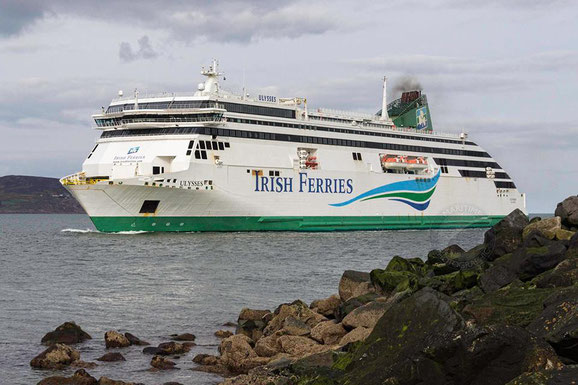
Whilst Irish Ferries kept growing, its competitors also kept growing, and therefore an always stronger competition was put in place on the Irish - Great Britain services. To kept being competitive, Irish Ferries had therefore to decide to launch a plan to cut its costs. This announcement caused a general outcry among the company's trade unions.
On 23rd February 2004, Irish Ferries' management announced that the company would be liquidated in the following weeks if costs were not cut. The Human Resources manager decided to put its staff under pressure by announcing the adjournment of all services operated from Rosslare and of the High Speed service between Dublin and Holyhead.
In early-2005, Irish Ferries announced that Normandy would be re-registered under a flag of convenience, enabling the company to replace its French and Irish crew by staff from other European countries, paid at lower wages. Despite the strikes organised in France, the company eventually re-registered the ship, firing all of its former crews.
On 24th March 2005, the trade union SIPTU revealed that Irish Ferries have hired a Phillipinian women, Salvacion Orge for Isle of Inishmore (2)'s Spa, paid €1 per worked hour. This induced a general outcry and Irish Ferries had to close down the Spa, firing Mrs Orge. However, she refused landing and the company had to negotiate with her to enable her landing on 29th March. She was given a €24,000 compensation, and an extra-€1000 given by the ship's crew, and was sent back to the Philippines.
On 19th September, Irish Ferries enforced a plan of voluntary redundancies, which was the conclusion of an agreement found with the SIPTU trade union following negotiations which took place in 2004, to redundant 543 staffs. Irish Ferries justified this plan by the rise of fuel costs (that have increased by 50%) and the growing competition exercised by its competitors and the low cost air lines (with among other Irish-established Ryannair), inducing a 9% drop in the traffics carried by the company. Therefore, on 4th November 2005, Security Staff and four Engineers occupied Isle of Inishmore (2)'s engine room, and she had to remain berth during 22 days. They were protesting against the cost-cutting policy of the company.
A general strike lead by every Irish trade unions took place in Dublin on 5th December 2005 to demonstrate against Irish Ferries' cost-cutting policies . 100,000 people demonstrated, with 40,000 only in Dublin.
However, Blockades and Strikes did not overcome with Irish Ferries' resolution to cut costs and on January 2006 Isle of Inishmore (2), Jonathan Swift and Ulysses were re-registered in Cypra, with only 48 Irish crew kept within the company.
The return to profitability and growth
Irish Ferries' recovering
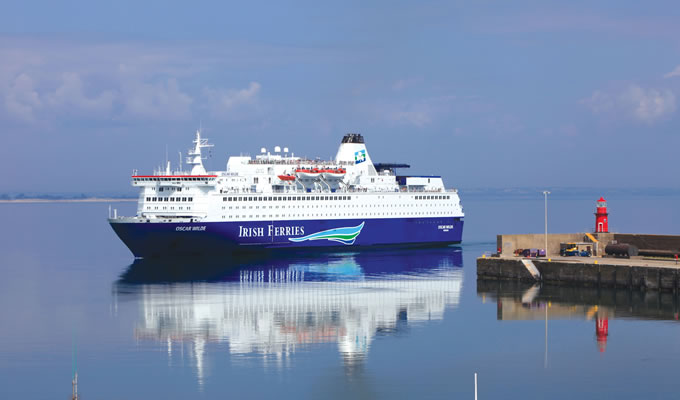
In late-2006, Irish Ferries announced that Pride of Bilbao's chartering contract have been renewed by P&O Ferries. Moreover, although P&O Ferries have ended Pride of Cherbourg (3) (former-Isle of Inishfree (2)) the previous year, she has been immediatly chartered out to Interislander.
On 17th January 2007, Irish Ferries announced that the company has purchased from Color Line Kronprins Harald, that would replace at the end of that year Normandy on the Ireland - France service.
In September 2007, 1986-built Kronprins Harald was renamed Oscar Wilde and sent to shipyard to be refitted and overhauled. Normandy arrived after her last France-Ireland crossing on 4th November in Frederica, replacing Oscar Wilde at her berth. Normandy was sold on 10th February 2008 to Equinox Offshore Accommodation for €15 millions.
Oscar Wilde performed her maiden crossing from Rosslare on 30th November 2007. Despite Irish Ferries' photomontages, Oscar Wilde retained her blue hull, whereas the rest of the fleet has a white hull with a Green strip at the bottom.
Back to Growth

Since the enforcement of the cost-cutting plan in 2006., traffic growth has resumed on the Dublin - Holyhead route. Hence, Irish Ferries announced in late-2013 that the company was to charter for the following year Cartour Epsilon, that would operate 2 return crossings on this service at week day, and a new Cherbourg-en-Cotentin - Dublin return crossing at week ends. When she was introduced on this new service, her name was shorten to Epsilon.
In 2014, Irish Ferries was given the title of The Year Best Ferries company by the Association of Irish Travel Agencies. The following year, the company celebrated the 20th Anniversary of its Roscoff services. This route enabled travellers being offered an other choice to head to the Atlantic coast, whilst enabling the Irish access gaining access to the Breton market. In 20 years, 1230 crossings have been operated on this route, with 1.5 million guests welcomed and 400,000 individuals cars carried. However, Irish Ferries is not considering offering a year-round service on this route.
Eventually, in late-May 2016, Irish Ferries announced that the company has just commissioned to German shipyard Flensburger Schiffbau-Gesselschaft & Co A.G. a new 50,000GT ship that is likely to replace Epsilon. This ship will be the first in Irish Ferries to be equipped with exhaust scrubbers, and will be able to welcome 1,885 guests, 300 cars and 165 lorries. This €144 million ship is to be the most comfortable ship ever introduced by Irish Ferries on one of its route. Construction work has begun immediately, with delivery scheduled in 2018.


